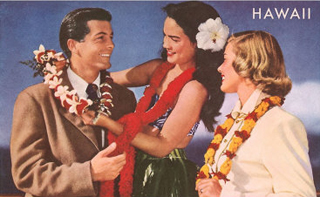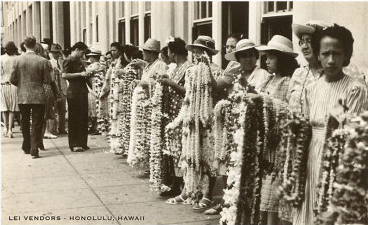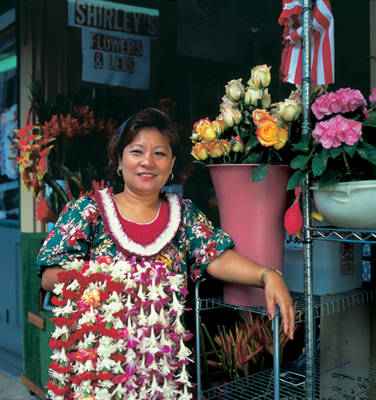Human Flower Project
Wednesday, March 12, 2008
Today’s Hawaiian Lei (Kiss Not Included)
Competition from Asian growers and airport security are stifling Hawaii’s famed floral greeting.

Mr. and Mrs. Mainland Get a Blast of Aloha
Image: art.com
In the late 1800s, visiting Hawaii meant sloshing over hundreds of ocean miles: The Boat Days, they call it in the islands. To be greeted with a lei after braving the seas (or before, if one were headed back to the mainland) seems to have caught on quickly, an indelible tourist experience that swiftly became part of travelers’ expectations and tour guides’ provisions. Lore grew around the lei custom, too:
“It was said if a departing visitor tossed their lei into the ocean and it floated back to the beach, it meant that the person would someday return to the islands. Hundreds of leis could be seen floating in the crystal waters off of Diamond Head as a ship steamed away.” (Anyone who finds this too sentimental, please break a brick with your head!)
 Lei Vendors in Honolulu
Lei Vendors in Honolulu
Photo: via art.com
The University of Hawaii has posted a brief history of the lei tradition based around interviews with Honolulu lei vendors. It notes, “By the turn of the (20th) century, the lei industry was well established in Honolulu. Hawaiian lei sellers — generally women — were visible on the sidewalks of downtown Honolulu in the area of Hotel, Maunakea, and Kekaulike streets.” Travel to the islands swelled in the late 1920s, as Matson Navigation Company began luxury liner service between California and Honolulu. The lei sellers, picking flowers from their own yards and local farms, strung garlands and brought them to the waterfront on steamer days (usually twice monthly). With the beginnings of air travel in the 1940s, some moved to the airport, selling their flowers from the backs of trucks.
“(We) had all these jalopies. We just build a stand on. No more electricity over there. Just a dark road and don’t even have street lights. What we have is gas lanterns. We hang it onto the stand. This is how it started,” said seller Harriet Kauwe.
And today? Hawaiian tourists have come to expect the lei greeting. And it’s still provided though the circumstances, the vendors and the flowers themselves are changing fast. Most of the lei sellers on Maunakea Street today are Filipino women, not Hawaiians. Nearly all lei greetings take place not at the shining waterfront or even the airport gate. Instead, airport regulations require “greeting companies” to station representatives in the baggage area holding out signs with passengers’ names (limousine-service style). One company explains: “After deplaning, clients should recognize their name sign. In the traditional way of saying Aloha, a lei, specially selected from one of our four service categories, will then be presented” (we’re not sure if a kiss comes with that).
 Shirley Magaoay, a lei vendor born in the Philippines
Shirley Magaoay, a lei vendor born in the Philippines
at her shop on Maunakea St., Honolulu
Photo: Olivier Koning
Also, it’s likely that the flowers looped around your neck will not be Hawaiian. The state’s annual summary of the flower and nursery business found that Hawaii-grown lei flowers had been steeply declining for several years. Production of plumeria, creamy yellow and highly favored for leis, was down by half from 2002. Cultivation of pikake (Jasminum sambac), a pearly and more traditional lei flower in the islands, was down even more. “In 2002, nine growers sold 81,000 (pikake) blossoms valued at $242,000. In 2006, five growers sold 23,000 flowers worth $60,000.” Carnation and tuberose production in Hawaii has sunk also.
What’s happened? As on the mainland, U.S. flower farmers can’t beat the cheap labor costs in Latin America. And Hawaiian growers find themselves in added competition with farms in Japan and Thailand. Not only were total blooms and revenues down between 2002 and 2006, so was the acreage dedicated to lei flower production. (You can find the whole report here.) We’d suppose that as in much of the rest of the U.S., flower growing simply doesn’t look like the most lucrative use of land, especially so in Hawaii where there’s not much of it and demand for a piece of paradise is high.
The one exception in this decline of locally grown lei flowers seems to be the orchid Miss Joaquim Vanda, a splashy purple and white blossom hugely popular in the 1930s that’s making a comeback. This flower doesn’t travel well, so Hawaiian blooms can still dominate the market. “To make a vanda lei requires somewhere in the neighborhood of 100 flowers,” said Richard Criley, horticulturist at University of Hawaii. “Of course, the old-style lei, the flat one, which uses only the principal lip petals, requires many, many more flowers. That would account for the increase right there.”
But Criley also believes that lei sales generally have fallen off. Perhaps Hawaii, more accessible now than ever, is also less exotic, and a fresh garland has a whiff of absurdity. All the new rules at U.S. airports have made greetings clumsy, too. “There used to be a whole slew of people waiting by the gates with lei in hand. Now, you have to wait at the baggage area, which isn’t as easy,” he says. No matter how much slack guitar music they pipe in, blinking alarms, Hertz and drug hounds, moving walkways and conveyor belts are mighty low in Aloha.
Culture & Society • Cut-Flower Trade • Florists • Secular Customs • Travel • Permalink




